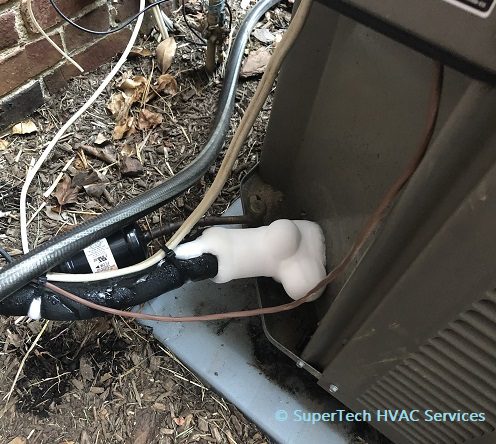If you find yourself faced with a frozen AC unit, don’t panic! We’ve got you covered. In this article, we will guide you through simple and effective steps to bring your AC unit back to life. Discover the common causes of a frozen AC unit, learn how to troubleshoot the issue, and implement the necessary fixes to ensure maximum cooling efficiency. Say goodbye to hot and stuffy rooms, and say hello to a perfectly functioning AC unit. Let’s get started on the path to a cool and comfortable home.
1. Common Causes of Frozen AC Unit
1.1 Lack of Airflow
One common cause of a frozen AC unit is a lack of airflow. This occurs when there are obstacles or blockages preventing the flow of air through the system. Some possible culprits include closed or blocked vents, furniture or other objects obstructing air registers, or a damaged air duct.
1.2 Dirty Air Filters
Dirty air filters can also lead to a frozen AC unit. When the air filters become clogged with dirt, dust, or debris, the airflow is restricted. This can cause the evaporator coil to become too cold and freeze up.
1.3 Low Refrigerant Levels
Low refrigerant levels can result in a frozen AC unit. Refrigerant is responsible for absorbing heat from the indoor air, and if there is not enough refrigerant in the system, the evaporator coil can become excessively cold and freeze.
1.4 Dirty Evaporator Coil
A dirty evaporator coil can contribute to the freezing of an AC unit. Over time, dust and dirt can accumulate on the coil, impairing its ability to absorb heat. This can result in the coil becoming too cold and freezing.
1.5 Malfunctioning Thermostat
A malfunctioning thermostat can cause the AC unit to freeze. If the thermostat is not accurately sensing the temperature or is not properly communicating with the cooling system, it may cause the system to run excessively, leading to a frozen unit.
2. Identifying a Frozen AC Unit
2.1 Ice Formation
The most obvious sign of a frozen AC unit is the presence of ice or frost on the indoor or outdoor components. Ice may form on the evaporator coil, refrigerant lines, or even on the outdoor condenser unit. This ice formation obstructs airflow and hampers the unit’s ability to cool effectively.
2.2 Reduced or No Airflow
Another indicator of a frozen AC unit is reduced or no airflow through the vents. If you notice that the air coming from the vents is weak or barely noticeable, it is likely that the unit has frozen up and is unable to push the cooled air into your living space.
2.3 Unusual Sounds
Unusual sounds can also suggest a frozen AC unit. If you hear unusual noises such as hissing, bubbling, or knocking coming from the AC system, there may be ice blocking the components or refrigerant leaks caused by the freezing process.
2.4 Warm Air
Contrary to what you might expect, a frozen AC unit can sometimes blow warm air instead of cold air. When the system freezes, the ice blocks the airflow, preventing the cooled air from circulating properly. As a result, the AC unit may blow warm or lukewarm air instead of the desired cool air.
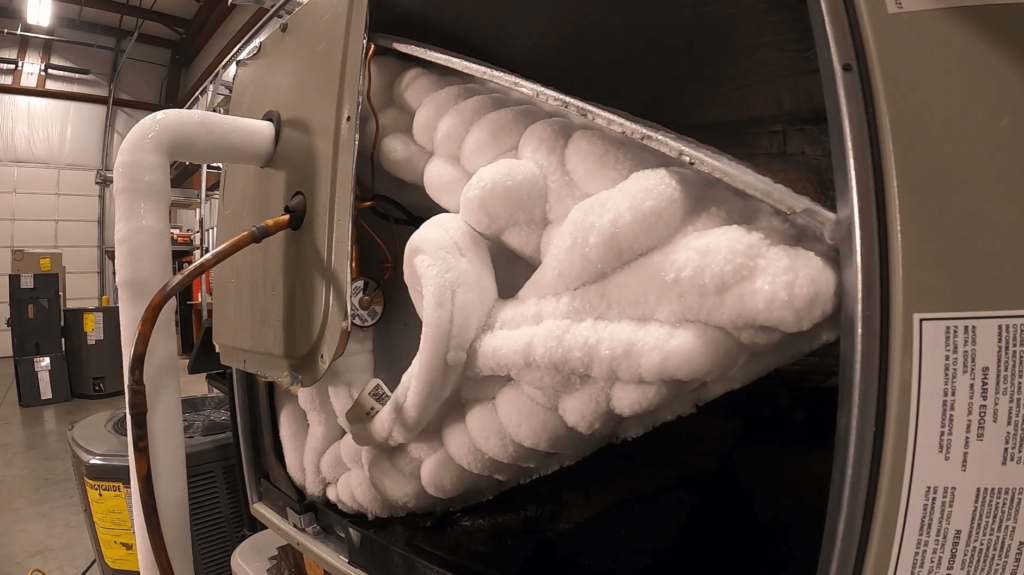
3. Turning Off the AC Unit
3.1 Locate the Circuit Breaker
The first step in addressing a frozen AC unit is to turn off the power. Locate the circuit breaker that controls your AC unit and switch it off to avoid any potential electrical hazards while working on the system.
3.2 Switch Off the AC Unit
Once you have located the circuit breaker, find the on/off switch on your AC unit and turn it off as well. This will ensure that the system is completely shut down and prevent any further cooling cycle that could worsen the freezing issue.
4. Thawing the AC Unit
4.1 Turn On the Fan
After turning off the power, switch on the fan setting on your thermostat. This helps to circulate warm air throughout the system and expedite the thawing process. Remember, you should only turn on the fan and not the cooling mode.
4.2 Run the Fan for Several Hours
Allow the fan to run for several hours to help melt the ice and thaw the AC unit. It is essential to give the system enough time to defrost completely. Be patient and avoid rushing the process to prevent any potential damage to the components.
4.3 Remove Ice Manually
Once the majority of the ice has melted, you can manually remove any remaining ice buildup. Use a plastic scraper or a soft cloth to gently scrape away the ice from the evaporator coil, refrigerant lines, and any other affected areas. Take care not to damage the components during this process.
4.4 Use a Hairdryer on Low Heat
If there are still persistent ice formations after using the fan and manually removing some ice, you can use a hairdryer set on low heat to thaw them. Be sure to keep the hairdryer at a safe distance and avoid directing the heat directly onto any electrical components.
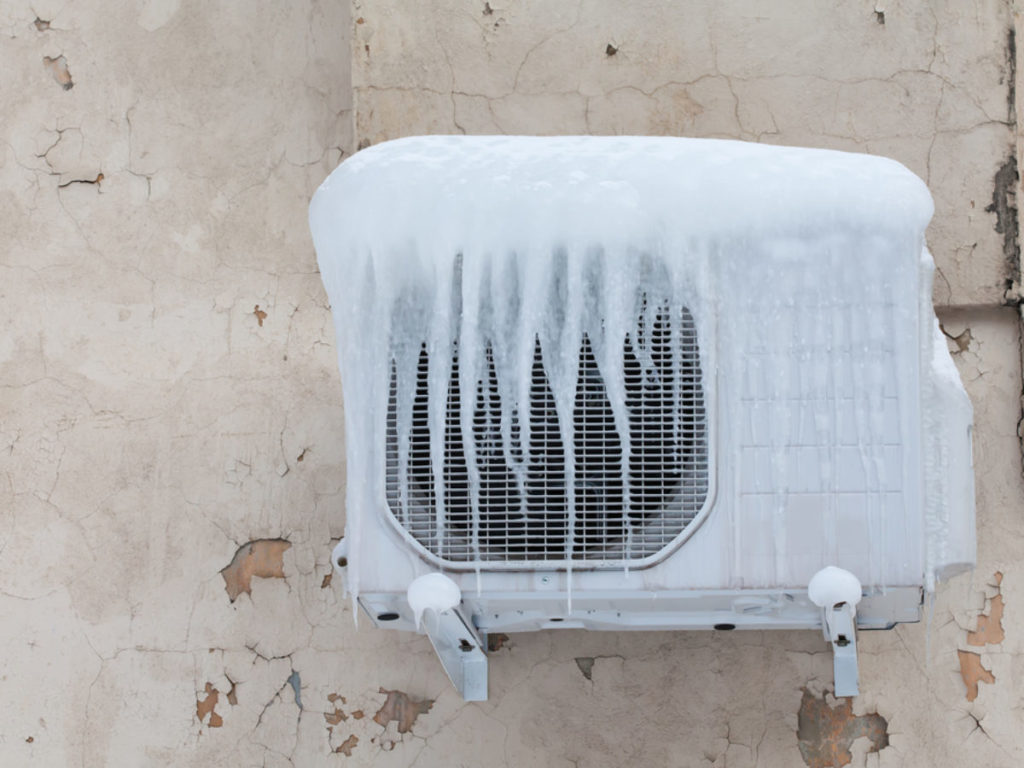
5. Checking Air Filters
5.1 Remove and Inspect Air Filters
After thawing the AC unit, it is crucial to check the condition of the air filters. Remove the filters and inspect them for dirt, dust, or debris accumulation. If the filters are visibly dirty or clogged, they need to be either cleaned or replaced.
5.2 Clean or Replace the Filters
If the filters are reusable, clean them according to the manufacturer’s instructions. This typically involves rinsing them with water or using a vacuum cleaner to remove the accumulated dirt. For disposable filters, discard the old filters and replace them with new ones that are compatible with your HVAC system.
6. Inspecting Refrigerant Levels
6.1 Hire a Professional
Inspecting and replenishing refrigerant levels should be done by a qualified HVAC professional. They have the necessary tools and expertise to handle refrigerant safely and accurately. Attempting to do it yourself may lead to serious injury or further damage to the AC unit.
6.2 Check for Refrigerant Leaks
While a professional should handle the actual inspection and replenishing of refrigerant levels, you can help identify potential leaks. If you notice a strong, sweet smell or oil stains around the AC unit, it may indicate a refrigerant leak. In such cases, it is essential to contact a professional as soon as possible to assess and repair the leak.
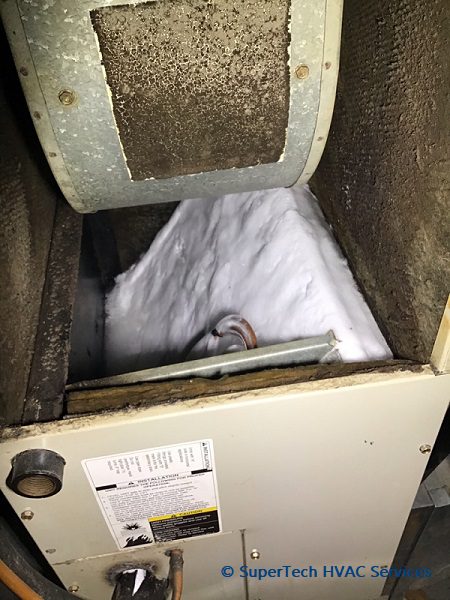
7. Cleaning the Evaporator Coil
7.1 Turn Off the AC Unit
Before cleaning the evaporator coil, ensure that the AC unit is powered off. This eliminates the risk of electrical shock and allows you to work on the coil safely.
7.2 Access the Evaporator Coil
The location of the evaporator coil may vary depending on your AC unit. It is typically found in the indoor air handler or in the basement near the furnace. Refer to your AC unit’s manual or consult a professional if you are unsure of its exact location.
7.3 Use a Brush or Soft Cloth
Once you have accessed the evaporator coil, gently brush away any loose debris using a soft-bristled brush. Alternatively, you can use a soft cloth to wipe away dust and dirt from the coil. Take care to avoid applying excessive force that could damage the delicate fins of the coil.
7.4 Clean the Coil Gently
If you find stubborn dirt or grime on the evaporator coil, you can use a mixture of mild dish soap and warm water to clean it. Dip a cloth or sponge into the soapy solution and wipe down the coil, ensuring that you are thorough but gentle. Rinse the coil with a damp cloth to remove any soap residue once you have finished cleaning.
8. Repairing or Replacing the Thermostat
8.1 Test the Thermostat
If you suspect a malfunctioning thermostat, test it to ensure it is accurately reading the temperature and sending the correct signals to the AC unit. This can be done by adjusting the temperature settings and observing the system’s response. If the temperature does not change or is inconsistent, the thermostat may require repair or replacement.
8.2 Check Batteries
Sometimes, a thermostat may simply have low or dead batteries. Check the battery compartment of your thermostat and replace the batteries if necessary. Low battery levels can cause erratic thermostat behavior, leading to freezing or other issues with the AC unit.
8.3 Calibrate or Replace the Thermostat
If testing the thermostat and replacing the batteries does not resolve the issue, it may be necessary to calibrate or replace the thermostat. Calibrating involves using a screwdriver to adjust the temperature sensor to improve accuracy. However, if the thermostat is outdated or damaged, replacing it with a new, programmable thermostat may be the best solution.
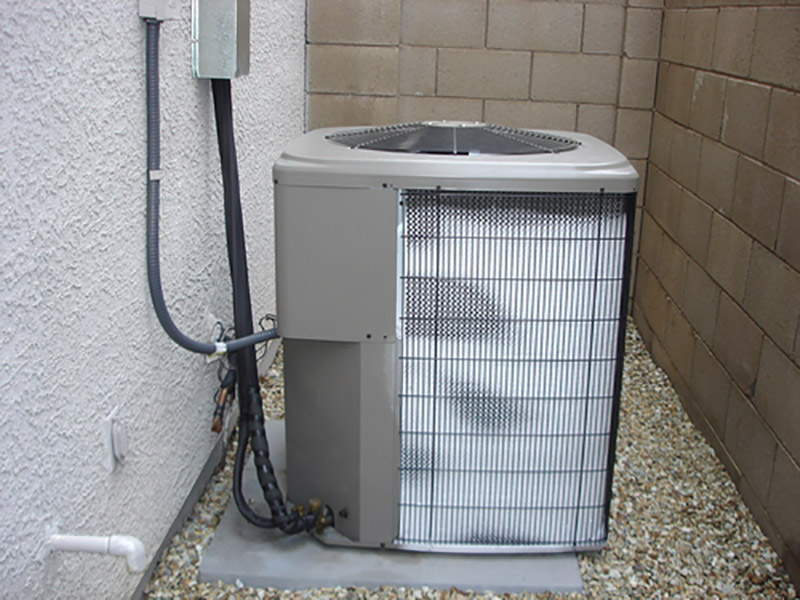
9. Preventing Future Freezing
9.1 Regularly Inspect and Clean Air Filters
To prevent the recurrence of a frozen AC unit, it is crucial to regularly inspect and clean or replace the air filters. This helps maintain proper airflow and prevents dirt and debris from interfering with the cooling process. Aim to clean or replace the filters every one to three months, depending on usage and the manufacturer’s recommendations.
9.2 Schedule Annual AC Maintenance
Scheduling annual AC maintenance with a professional HVAC technician can help identify and address any potential issues before they lead to a frozen unit. During the maintenance visit, the technician will clean the system, perform necessary repairs, check refrigerant levels, and ensure optimal performance.
9.3 Ensure Proper Insulation
Properly insulating your home can help prevent freezing issues with the AC unit. Insulation helps maintain consistent temperatures throughout the house, reducing the strain on the cooling system and minimizing the risk of freezing. Make sure your home’s windows, doors, walls, and attic are adequately insulated.
9.4 Keep Vents and Registers Clear
Ensure that all vents and registers in your home are clear and unobstructed. Blocked vents can disrupt the airflow, leading to inefficient cooling and potential freezing of the AC unit. Regularly check and remove any furniture, curtains, or other objects blocking the vents to maintain proper airflow.
10. Calling a Professional
10.1 DIY Troubleshooting First
Before calling a professional, you can attempt some troubleshooting steps yourself. Thawing the AC unit, checking air filters, and inspecting the thermostat are tasks that can be done by homeowners. However, if the issue persists or worsens, it is recommended to seek professional help.
10.2 When to Seek Professional Help
There are certain situations when it is advisable to call a professional HVAC technician. If you are unsure about any aspect of the troubleshooting process, if you suspect refrigerant leaks, or if your attempts to fix the problem have been unsuccessful, it is best to enlist the expertise of a qualified professional. They can accurately diagnose and repair any underlying issues with your AC unit.
